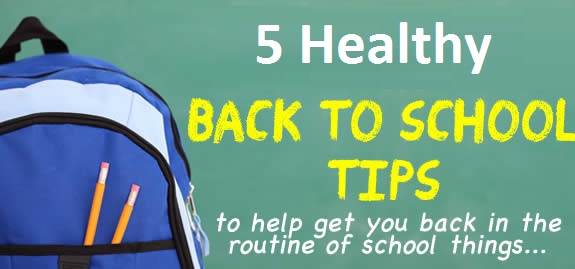
The best to start off the new school year, or anything really, is to plan ahead.
According to the American Academy of Pediatrics (AAP), these 5 tips will help you and your family have a safe and happy school year.
1. The First Day of School
-
If your child seems nervous, remind him or her that there are probably a lot of students who are uneasy about the first day of school. This may be at any age. Teachers know that students are nervous and will make an extra effort to make sure everyone feels as comfortable as possible.
-
Point out the positive aspects of starting school to create positive anticipation about the first day. Your child will see old friends and meet new ones. Refresh his or her positive memories about previous years, when he or she may have returned home after the first day with high spirits because of a good time.
-
Find another child in the neighborhood with whom your student can walk to school or ride on the bus.
-
If it is a new school for your child, attend any available orientations and take an opportunity to tour the school before the first day.
-
If you feel it is needed, drive your child (or walk with him or her) to school and pick him or her up on the first day.

2. Backpack Safety
-
Choose a backpack with wide, padded shoulder straps and a padded back.
-
Pack light. Organize the backpack to use all of its compartments. Pack heavier items closest to the center of the back. The backpack should never weigh more than 10 to 20 percent of your child’s body weight. Go through the pack with your child weekly, and remove unneeded items to keep it light.
-
Always use both shoulder straps. Slinging a backpack over one shoulder can strain muscles.
-
Adjust the pack so that the bottom sits at the waist.
-
If your school allows, consider a rolling backpack. This type of backpack may be a good choice for students who must tote a heavy load. Remember that rolling backpacks still must be carried up stairs, they may be difficult to roll in snow, and they may not fit in some lockers.

3. Traveling To & From School
School Bus
-
Children should always board and exit the bus at locations that provide safe access to the bus or to the school building.
-
Remind your child to wait for the bus to stop before approaching it from the curb.
-
Make sure your child walks where he or she can see the bus driver (which means the driver will be able to see him or her, too).
-
Remind your child to look both ways to see that no other traffic is coming before crossing the street, just in case traffic does not stop as required.
-
Your child should not move around on the bus.
-
If your child’s school bus has lap/shoulder seat belts, make sure your child uses one at all times when in the bus.
-
Check on the school’s policy regarding food on the bus. Eating on the bus can present a problem for students with food allergies and can also lead to infestations of insects and vermin on the vehicles.
-
If your child has a chronic condition that could result in an emergency on the bus, make sure you work with the school nurse or other school health personnel to have a bus emergency plan.
Bike
-
Always wear a bicycle helmet, no matter how short or long the ride.
-
Ride on the right, in the same direction as auto traffic and ride in bake lanes if they are present.
-
Use appropriate hand signals.
-
Respect traffic lights and stop signs.
-
Wear bright-colored clothing to increase visibility. White or light-colored clothing and reflective gear is especially important after dark.
Walking
-
Make sure your child’s walk to school is a safe route with well-trained adult crossing guards at every intersection.
-
Identify other children in the neighborhood with whom your child can walk to school. In neighborhoods with higher levels of traffic, consider organizing a “walking school bus,” in which an adult accompanies a group of neighborhood children walking to school.
-
Be realistic about your child’s pedestrian skills. Because small children are impulsive and less cautious around traffic, carefully consider whether or not your child is ready to walk to school without adult supervision.
-
If your children are young or are walking to a new school, walk with them or have another adult walk with them the first week or until you are sure they know the route and can do it safely.
-
Bright-colored clothing will make your child more visible to drivers.
4. Eating During the School Day
-
Studies show that children who eat a nutritious breakfast function better. They do better in school, and have better concentration and more energy.
-
Most schools regularly send schedules of cafeteria menus home and/or have them posted on the school’s website. With this advance information, you can plan on packing lunch on the days when the main course is one your child prefers not to eat.
-
Many school districts have plans which allow you to pay for meals through an online account. Your child will get a card to “swipe” at the register. This is a convenient way to handle school meal accounts.

5. Develop Good Study/Homework Habits
-
Children need a consistent work space in their bedroom or another part of the home that is quiet, without distractions, and promotes study.
-
Schedule ample time for homework; build this time into choices about participation in after school activities.
-
Establish a household rule that the TV and other electronics stay off during homework time.
-
Supervise computer and Internet use.
-
Be available to answer questions and offer assistance, but never do your child’s homework for him or her.
-
Take steps to help alleviate eye fatigue, neck fatigue and brain fatigue while studying. It may be helpful to close the books for a few minutes, stretch, and take a break periodically when it will not be too disruptive.
-
If your child is struggling with a particular subject, speak with your child’s teacher for recommendations on how you or another person can help your child at home or at school. If you have concerns about the assignments your child is receiving, talk with his or her teacher.
-
If your child is having difficulty focusing on or completing homework, discuss this with your child’s teacher, school counselor, or health care provider.
-
Some children need help organizing their homework. Checklists, timers, and parental supervision can help overcome homework problems.
-
Some children may need help remembering their assignments. Work with your child and his or her teacher to develop an appropriate way to keep track of his or her assignments–such as an assignment notebook.
-
Establish a good sleep routine.
